Comments:
- Waterproofing value
- Materials required for work
- Sequence of work
- Use of ready-made structures
Waterproofing of a septic tank made of concrete rings is very important, because in the absence of a central sewage system, they often resort to equipping sedimentation tanks for wastewater treatment.
A septic tank made of concrete rings is popular in suburban construction due to its reliability and durability.
There are many options for wastewater treatment systems. The septic tank can contain from one to three tanks, combined into a single system. Perhaps the most common is a two-chamber septic tank. Structurally, it consists of two containers or one, but divided into two parts. The first container, which is larger in volume, receives waste water. Here the main settling of heavy suspensions, their further fermentation and mineralization take place. In the next chamber, already clarified wastewater accumulates, finely dispersed suspensions are deposited, and from here the mostly purified water goes to additional soil purification.
For the construction of a sump, use different materials, including ready-made designs. Professionally performed work on the organization of the sump will give better results and take less time. But you can also independently build a two-chamber septic tank from concrete rings.
Waterproofing value
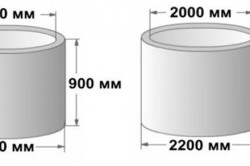
Low location groundwater and insufficient waterproofing, it is possible for pollutants to penetrate directly into the ground. Naturally, this is undesirable. An unpleasant smell can be one of the signs of a violation of waterproofing. This is the most harmless consequence.
The protection of reservoirs is especially weakened in winter, when, under the influence of natural processes, the soil layers are displaced, which can cause a violation of the integrity of the structure.
No matter how tightly the rings are fitted, fecal water can also seep into the soil through the seams, and concrete is susceptible to a kind of corrosion. The integrity of both the reinforcement cage and the concrete components may be compromised. As a result, soil and groundwater pollution occurs, which can negatively affect both the state of the environment in general and human health.
It is necessary to protect the concrete structure itself from the influence of groundwater. In the event of an additional amount of water, the sump simply will not be able to perform its function efficiently.
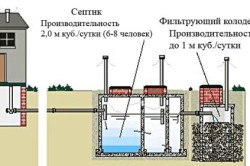
Aggressive substances that make up household chemicals, are also capable of affecting the integrity of the concrete surface, causing cracks and changes in the concrete structure. Therefore, when organizing septic tanks and their waterproofing, they resort to the use of special insulating materials, which ensures an increase in the service life of the structure.
For reliable protection waterproofing is performed on two sides (outside and inside the well).
Back to the table of contents
Materials required for work
To make a double-sided waterproofing of a sump, the following materials are used:
- rolled roofing material;
- various mastics from bitumen or combinations of polymers and bitumen;
- polymer mixtures;
- special waterproofing of a penetrating type (for example, penetron);
- injection waterproofing;
- silicone for sealing joints.
Of the tools you will need:
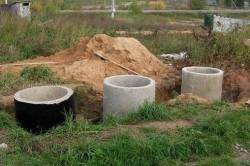
A septic tank made of concrete rings requires high-quality waterproofing.
- a brush with a metal bristle;
- scrapers and spatulas for surface preparation;
- containers (bucket or vat) for the preparation of emulsions and solutions;
- regular paint roller;
- brushes for applying mastic;
- electric drill with mixer.
And of course, you shouldn't forget about your own safety. Some industrial mastics can contain very harmful components, i.e. solvents, which themselves are quite toxic and volatile. Inhalation of their vapors may result in malfunction nervous system or allergies. Therefore, the use of a respirator is simply necessary.
Gloves will be needed to protect your hands. It is better to carry out work in a special robe, since it is very difficult to wash and wash off bituminous materials.
Back to the table of contents
Sequence of work
First, all surfaces of concrete wells must be thoroughly cleaned, since accumulations of dirt and dust can affect the quality of the adhesion of the insulating material. If a septic tank made of concrete rings has defects: cracks, chips - they must be eliminated by applying putty or sealants.
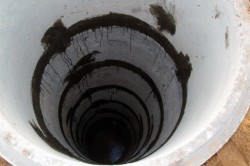
Much attention should be paid to waterproofing the seams of a concrete septic tank.
When performing waterproofing concrete well special attention is paid to the seams, bottom and wall joints, the places where the upper part of the rings and covers fit, as well as the pipe entry. The concrete rings must be sealed with silicone sealant (it is also possible to use cement mortar). It is recommended to insulate the pipe entry points with flexible material ( liquid rubber etc.). This is necessary so that when the well shrinks there is no rigid fixation of the pipes and they do not burst.
The next step is priming the surfaces of the septic tank made of concrete rings with a bituminous primer. The suspension must first be stirred and diluted with water. It is convenient to apply the ready-made primer using a regular construction brush or roller. The principle of application is the same as for conventional painting. The base is applied in two layers, with the second after the first has completely dried. Within 24 hours, the primer must penetrate deep into the concrete, therefore, further actions are performed after this time.
After finishing priming, you can start working with the mastic. The product is sold ready-to-use, you just need to stir it. This is where a drill with a mixer attachment working at low speeds comes in handy. You can, of course, stir the product with the materials at hand (for example, a wooden block).
The prepared mastic is applied to a septic tank from concrete rings with a paint brush. The applied layer should not be very thin, have no smudges and evenly cover the surface.
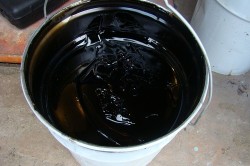
Before applying the mastic to the septic tank, mix it well.
After the mastic is completely dry, you need to very carefully inspect the surface for any breaks or thinning of the layer. If any defects are found, apply a second coat in the same way. Such a coating usually dries no more than three days.
The outer part of concrete wells is treated with welded waterproofing materials.
Another way of arranging the waterproofing of sedimentation tanks is plaster, carried out under the influence of pressure. This process involves special non-shrinking cement. All work is carried out using compressed air supplied under high pressure.
With this method of waterproofing, the coating is uniform and sufficiently dense over the entire area.But there are also disadvantages to this technology.
To perform such work, you will need special equipment, the so-called cement gun. At least two layers of insulating material are applied, their thickness should be from 5 to 10 mm. All these manipulations must be carried out at an ambient temperature of at least + 5 ° C.
Each next layer can be applied only after the previous one has completely solidified. This means that the waterproofing of the septic tank can take almost half a month.
If work is carried out during a hot period, then it is necessary to water the coating every three to four hours. If the air temperature is not very high, the intervals between wetting the surface can be up to 12 hours.
Concrete structures need waterproofing for several reasons. This is leaching of concrete stone, and corrosion of the reinforcing cage, and other types of chemical and biological corrosion. Therefore, waterproofing concrete structures necessary and obligatory, otherwise the latter will quickly lose their bearing and structural qualities. In some cases, replacing concrete products is almost impossible. For example, you cannot remove the foundation of a house and replace it with a new one, so only expensive and complex repairs, excavation of the foundation walls and work on their waterproofing remain. Such measures will be many times more expensive and more difficult than timely waterproofing work.
Concrete rings are special reinforced concrete products for the construction of wells and septic tanks, various elements sewerage systems and drinking water storage systems. Waterproofing a septic tank made of concrete rings is one of the most discussed topics, so you can dwell on it in more detail.
Septic tank device
A septic tank is a sewerage structure, which is most often made from two to three wells connected by overflow pipes. Moreover, in the case of three wells, the first two have a bottom, and the third is a filtration one, and the water goes into the ground through a layer of rubble, which is necessary for additional water filtration.
In the first well, the primary settling of suspended particles and solid impurities occurs. In the second well, this process continues, in addition, the precipitation of the products of various chemical reactions occurring in the wastewater occurs. The third well passes water into the ground through a layer of filtration rubble.
All these measures are necessary in order to avoid contamination of the soil by microorganisms, to prevent the occurrence of an unpleasant odor on the site, and so that there are no problems with the sanitary and epidemiological station and supervisory authorities.
It is not recommended to build such structures on your own. It is also necessary to use a crane. The sewerage system must comply with SNiP standards, pipe slope coals, overflow levels, etc. must be maintained.
As you can see, the septic tank is exposed to an aggressive environment from the inside and groundwater from the outside. Ground waters, by the way, are also not devoid of acids and alkalis, so their effect on concrete products is considered to be harmful.
The septic tank consists of at least two wells, the installation of which is carried out using lifting equipment
Waterproofing septic tanks
External and internal waterproofing of septic tanks must be performed without fail. Do not believe those who say otherwise. If wastewater begins to seep into the ground in the first well at a high overflow level, then the "piquant" smell will become a distinctive feature of your site.
So, we have defined:
- waterproofing a septic tank is a necessary measure;
- it is better to carry out work on the installation of the sewer system with the help of professionals;
- as a result of poor or missing waterproofing, a number of problems can arise: from the destruction of the structure of the septic tank - to seepage of sewage into the ground and, as a result, an unpleasant smell in your and neighboring areas;
- waterproofing a septic tank is a discussed and urgent problem.
But what exactly is the problem? The problem is that the waterproofing must be solid and monolithic, and the well rings, according to some builders, will shift relative to each other and break the waterproofing coating:
- First, you can use rings with special locks.
- Secondly, the rings are held together with staples and plates.
- Thirdly, there are types of waterproofing that are not afraid of such movements.
![]()
Installation of concrete rings is complex and requires the participation of experienced builders
Penetrating waterproofing
For waterproofing a septic tank made of concrete rings, it is best to use penetrating waterproofing. If you process the well from both sides, then the waterproofing will penetrate the entire thickness of the wall and the concrete will be safe. This will extend its service life at times.
Waterproofing of concrete joints, which are also considered a problem area of \u200b\u200ba well or septic tank, can also be done using penetrating insulation and treatment with special cement mixtures, which are provided by almost all manufacturers of penetrating mixtures, for example, Penetron produces them in large quantities for different purposes and cases.
No matter how well the seam has been processed, it is still necessary to take all measures to maximize the fixation of the rings and prevent their displacement relative to each other.
Usually, the pit for the septic tank is made wider so that you can go down and carry out work on waterproofing the surface and processing the seams.

Scheme of applying penetrating waterproofing on concrete rings
First, the seams are processed. This should be done even when installing the rings. Often used o-rings and gaskets, but, in any case, the rings should be placed on cement mortar. You can immediately use a penetrating mixture, then the seal of the seam will be especially reliable.
After the seams are processed, the penetrating insulation is applied in accordance with the manufacturer's instructions.
It is important to know: non-compliance with the instructions or incomplete compliance with their requirements can lead to poor-quality waterproofing and the need for re-processing.
Bituminous waterproofing
Traditional bituminous materials are also used for the treatment of septic tanks. Hot bitumen is a good insulation, but its service life is too short, it cracks and flakes, does not tolerate frost and thawing well. Bituminous mastics, which contain special additives to increase elasticity, frost resistance and adhesion to a concrete surface, will last much longer. Mastics are applied in a cold way, which is also important from the point of view of the complexity and timing of the work.
![]()
Bituminous insulation can be used in combination with a clay lock
Polymer insulation
If penetrating insulation is expensive for you, and bituminous insulation is in doubt, you can use cement-based or polymer-cement insulation. The service life of such insulation is noticeably longer than that of bituminous, it is applied just as easily, with a regular brush in two layers, and the second is applied almost immediately, as soon as the first one has begun to set, that is, according to the "wet on wet" principle. Seams can be sealed with silicone sealant.
Clay lock for outdoor protection
Also, for the outer insulation of the surface of the septic tank well, the so-called. clay castle. To do this, the well is covered with clean clay, without sand, which is rammed. Thus, ground water cannot penetrate to the concrete surface. However, this method is best used in conjunction with other measures such as caulking or penetrating insulation.

The thickness of the lock is taken at least 20 - 25 cm
Use of plastic materials
You can also take extreme measures, such as putting on a septic tank. plastic pipe... For this, barrels or pipes made of PVC or polyethylene are used, but it is not clear why not immediately make a well from these materials.
There are a lot of tools for the treatment and waterproofing of concrete products today, we will list them all at the end of the article. The main thing is to choose the right, and especially to apply the material. Whatever the choice of method for waterproofing, this is a necessary and important measure, this should be remembered by any builder.

PVC pipes double-walled designed for external networks of domestic and storm sewers
Waterproofing of concrete tanks
Concrete tanks are widely used in the construction of sewerage systems, collectors, storm sewers, tanks for purification and storage of drinking water, etc. Waterproofing measures for concrete tanks must be carried out without fail, otherwise the concrete will corrode and lose its properties. As a result, the service life of the structure is significantly reduced, and its repair or replacement is required, which is very difficult and expensive.
Types of corrosion of concrete structures
- Leaching of lime from the concrete body and its removal to the outer surface by diffusion water with the formation of stalactites (growths) and whitish streaks.
- Corrosion due to exposure to magnesia and sulphate salts. As a result of the interaction of these salts with lime, calcium sulfoaluminate is formed, which is easily soluble. As a result, the concrete is destroyed.
- Corrosion caused by carbon dioxide, which reacts with calcium oxide hydrate and causes undesirable and destructive processes.
- Mechanical and physical corrosion that occurs during the freezing and thawing cycles of water. Water expanding during freezing can tear the concrete body and cause cracks and fractures.
- Biological corrosion due to exposure to waste products of microorganisms, mold fungi, mosses and other representatives different forms life.
- Destruction caused by non-compliance with the rules and regulations for laying, curing and preparing concrete.
- Chemical and electrochemical interaction of fittings with water and electrolytes, as well as metal oxidation and corrosion.
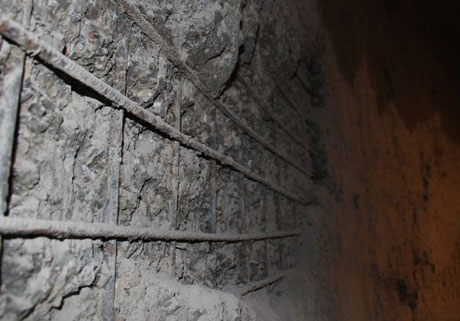
As a result of corrosion, the concrete body collapses and the reinforcement is exposed, which is unacceptable
These are not all types of destructive effects of water on concrete structures, only the main ones are listed here. However, these factors are quite enough to understand how necessary waterproofing of concrete tanks is.
Materials for protecting concrete from moisture
For waterproofing works apply different methods and materials:
- penetrating waterproofing;
- injection waterproofing;
- coating cement and polymer-cement insulation;
- coating bituminous and bitumen-polymer waterproofing;
- polymer insulation;
- insulation with roll materials.
At different times, various methods of protecting concrete from water have been used, including the methods listed above. However, some are difficult and expensive, such as injection or polymer insulation, others are ineffective or short-lived.
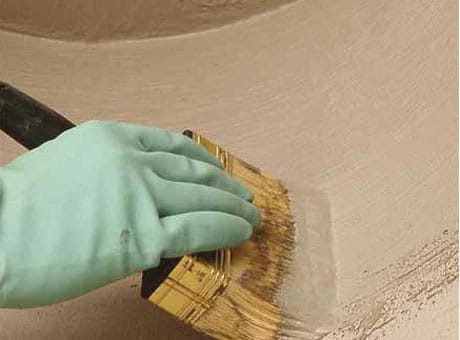
Waterproofing concrete with a two-component cement mortar is done with a conventional brush
Therefore, based on experience, three main methods can be distinguished: penetrating and coating polymer-cement and bitumen-polymer insulation.
Bituminous formulations are not suitable for all tanks, as drinking water should not come into contact with such substances.
The application of penetrating and polymer-cement insulation does not cause difficulties and does not require special qualifications from workers. The only condition is strict compliance with the manufacturer's instructions, proper care during the "ripening" period and the use of known and proven materials.
It is also important to remember about the processing of seams and joints of concrete structures. For these purposes, silicone sealants and special compounds are used for cement base.
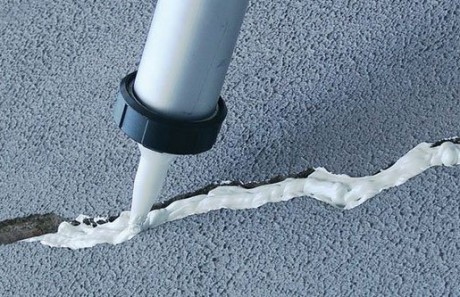
Seams can be treated with sealants
Whatever the method of waterproofing concrete structures, it is better that it is chosen by a professional based on the environment, the purpose of the tank, the grade of concrete, etc. Work is best done with the help of specialists in this field who have experience and are familiar with various materials and methods of their application. Poorly executed waterproofing is, one might say, missing waterproofing, so it is better not to save money and turn to professionals.
Without additional protection in an aggressive environment, concrete structures lose their strength characteristics. Therefore, waterproofing a septic tank from concrete rings is necessary. If you do not pay due attention to this process, then very soon you will have to face many unpleasant problems. Eliminating them is a waste of time, nerves, and sometimes not so small means.
In concrete, under the influence of moisture, lime leaching is observed, which manifests itself in the appearance of stalactites and growths on the surface of the rings. The material is destroyed by magnesia salts contained in groundwater.
Reacting with lime, they create a compound that is readily soluble in water - calcium sulfoaluminate, which water flushes out of the concrete body, destroying it.
The impact of groundwater and the liquid component of wastewater on the walls of a concrete well gradually leads to a breakdown of structural bonds in the thickness artificial stone... The result of violations is cracks and cavities through which untreated sewage masses can seep into the ground
Carbon dioxide, also present in groundwater, triggers destructive processes in concrete by reacting with calcium oxide hydrate. Water entering microcracks and pores turns into ice when the temperature drops. An increase in its volume leads to faults and large cracks in the already porous structure of the material. Biological corrosion of concrete is caused by microorganisms living in water.
Salt solutions, in contact with metal reinforcement in the body of concrete, cause electrochemical corrosion of steel. Due to its gradual destruction, the strength characteristics of the product are reduced, and then the structure becomes completely unusable. Replacing concrete rings is fraught with many difficulties, and sometimes it is simply impossible.
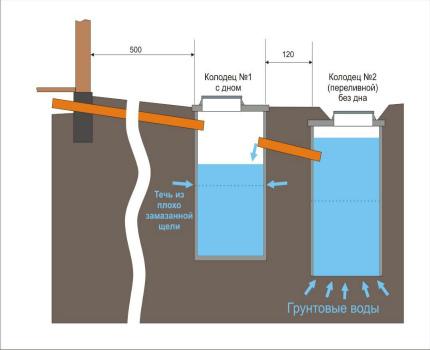
Without reliable waterproofing melt and rainwater will enter the first well of the septic tank, overflowing it and disrupting the normal operating cycle of the system
If you do not protect the septic tank from the effects of destructive factors, then dirty water will fall into the ground and infect it with microorganisms. An unpleasant smell will appear on the site, and representatives of the supervisory authorities will become your frequent guests. All these reasons are enough to allocate funds and time to perform high-quality waterproofing of a septic tank, thereby avoiding problems with frequent and time-consuming repairs.
Particular attention should be paid to waterproofing the bottom of the first well at its junction with the bottom ring. The base is concreted using mesh as reinforcement.

When exposed to aggressive factors, reinforced concrete rings will begin to collapse, and the reinforcement will rust. Therefore, already at the construction stage of the septic tank, it is necessary to perform waterproofing
Types of waterproofing for a septic tank
There are many materials to increase the strength of concrete rings from the outside and from the inside. The most commonly used are:
- Sprayable compounds. The rings are processed with them from the outside using special equipment.
- Injection protection. It can be epoxy, mineral or polyurethane based. For septic tanks, it is used in extreme cases, since it is expensive.
- Lubricating compounds. Bituminous and bitumen-containing. These are film-forming mixtures that, when applied in several layers, create a thin layer impervious to water.
- Rolled materials. They are used for gluing waterproofing. They are stabilized bituminous or bitumen-polymer mastic, applied to a fabric base made of geotextile or glass fiber.
- Penetrating compounds. Insoluble crystalline hydrates are formed in the thickness of concrete, which create a reliable hydro-barrier from the side of application to the penetration depth declared by the manufacturer.
Many different waterproofing materials come to the construction market, it is not so easy to understand them and choose the right one.
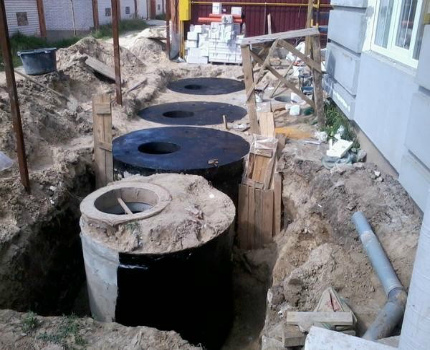
Of existing species waterproofing you need to choose the most affordable, both technologically and financially
According to the criteria of durability and reliability, each type of waterproofing is different from each other. So, bituminous protection begins to crack after a few years, and mastic has a longer service life.
Spraying waterproofing material
This type of insulation allows you to create a monolithic seamless layer. Water-repellent emulsions are sprayed onto the surface of the concrete rings under high pressure. The composition penetrates into cracks, cracks, pores and completely fills them, blocking drains in a confined space. The composition for spraying contains a polymer composite, water and fillers such as talc, calcium carbonate, titanium dioxide, barium sulfate.
The use of spray-applied waterproofing has many advantages:
- Speed \u200b\u200bof execution.
- Excellent adhesion to concrete surface.
- Fast solidification.
- Durability. Operated for up to 20 years without losing its original efficiency.
- Resistant to rapid temperature changes.
Sprayed waterproofing significantly improves the performance of the septic tank, thereby preventing the penetration of wastewater into the surrounding soil.
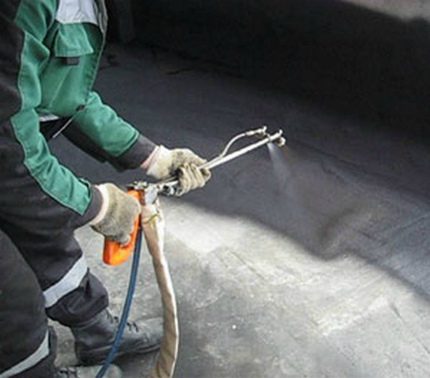
Special equipment is required to spray waterproofing. This is an expensive method, but very effective.
This type of waterproofing provides molecular adhesion to the surface of concrete rings. It can be applied over the old layer by spraying. The main thing is to remove excess moisture from the surface before this.
Septic tank lubricants
Compared to other waterproofing technologies, the advantage of using coatings is that they can be applied to surfaces of any geometry. No special apparatus and mechanisms are required for this. There are 4 groups of coating compositions, which differ in the base, which is used as:
- bitumen;
- cement;
- polymers.
The 4th group includes mastics containing sealants. Regardless of the basis, coating waterproofing fills in the slightest cracks, removes defects and makes the surface monolithic.
Some brands of bitumen-polymer mastics contain volatile toxic compounds. Sometimes they provoke disorders of the nervous system, lead to poisoning, therefore, you need to work only using protective equipment - a respirator, gloves, special overalls.
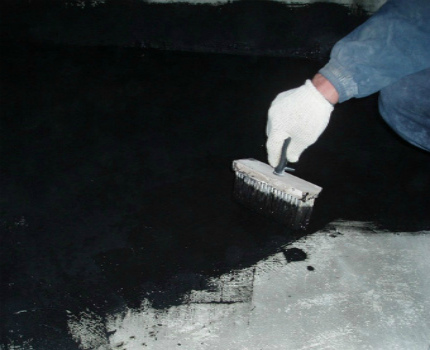
Bitumen-based coating waterproofing is very popular, but not very durable
When groundwater is at great depth, it strengthens the insulation of the lower ring of the septic tank. If they lie high, then the sealing of the top of the structure must be strengthened.
Bitumen-polymer coating compositions
This type of mastic contains polymer additives and latex, due to the presence of which the characteristics of the material change in better side... When applied to a surface, an elastic, very durable layer is created that retains its qualities at low temperatures. But in order for the bitumen-polymer composition to work, it must be applied in several layers.
The mastic is relatively inexpensive, you can apply it yourself, and if leaks appear somewhere, then the layer is easy to restore.
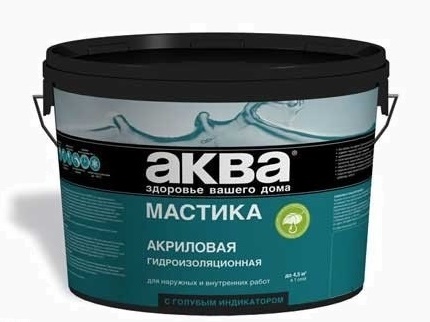
The presence of polymers in the mastic makes it very effective. The low popularity of this type of mastics is explained by the high cost
In addition, compared to other waterproofing technologies, the advantage of using coating materials is that they can be applied to surfaces with any geometry. No special apparatus and mechanisms are required for this. A distinction is made between mastic with a bitumen base and with additives in the form of polymers for cold and hot application.
Mastic for hot application is first heated to 160 degrees C, so that the bitumen goes into a plastic state. Then they cover the surface of concrete rings. Cold formulations are diluted with a solvent that evaporates after the insulation layer has hardened.
One- and two-component mastics are distinguished. Bitumen, polymer is always present in their composition, and additives that provide individual properties are different. Depending on the second component, the compositions are called: bitumen-latex, bitumen-rubber, bitumen-oil, bitumen-polyurethane.
Polyurethane and rubber make the material particularly flexible. The coating stretches well without cracking. The rubber mixture is applied cold. It has antiseptic properties and high heat resistance.
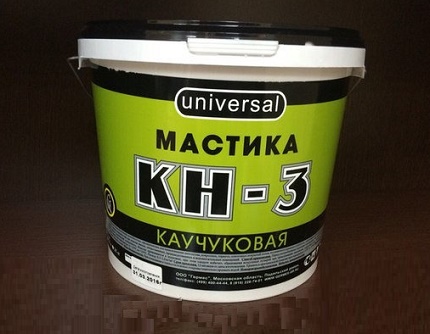
Rubber mastic resists the influence of aggressive environment well, withstands hydraulic pressure
A surface coated with a mixture of oil ingredients will not harden. It is sticky, well resists the aggressive influence of groundwater and soil, does not crack, and firmly endures both frosts down to -50 degrees C and high temperatures.
Rules for applying coating materials
Waterproofing is applied after sealing the inter-ring seams and the places where the pipes enter the septic tank. The process itself consists of 5 sequential stages:
- Cleaning the surface from dirt, identifying defects, cracks and eliminating them using sealants or putty.
- Application of a bituminous primer as a primer. It is first prepared by following the manufacturer's instructions, then the surface is coated with a construction brush. Bituminous primer You can also make it yourself, for which they take gasoline or the development of engine oil, heat it up and add crushed clean construction bitumen. While stirring, the mixture is heated to 200 degrees C, after which the primer is ready for use. The first layer is applied, and after it dries, the second.
- Leave everything for 24 hours. During this time, the primer will dry completely and its fine particles will penetrate deep into the concrete.
- Apply mastic with a construction brush, after thoroughly mixing the composition. If the mixture is too thick, dilute it with any organic solvent. After completing the first layer, take time to dry it and repeat the procedure.
- Check the quality of the applied layer after it dries. If flaws are found, the surface is treated again and left for 2-3 days to dry.
Bituminous mastic is much cheaper than bituminous materials with polymer additives. It adheres perfectly to concrete, has good water-repellent characteristics, and is resistant to chemicals. Bituminous mastic does not tolerate minus temperatures, the coating becomes brittle, covered with microcracks. Enough of such waterproofing for 5 years, maximum for 7.
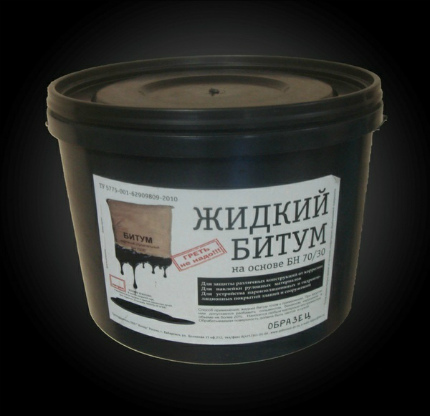
Liquid bitumen has elasticity, good adhesion to the concrete surface. This keeps the layer from tearing and cracking. One drawback - short service life
Some brands of bitumen-polymer mastics contain volatile toxic compounds. Sometimes they provoke disorders of the nervous system, lead to poisoning, therefore, you need to work only using protective equipment - a respirator, gloves, special overalls.
Clay castle device
A good result is obtained by processing the rings with bitumen mastic, followed by a clay lock. It means that the space between the concrete rings and the soil is filled with clay without any impurities. It is needed so that after melting snow or heavy rainfall, water does not get into the septic tank.
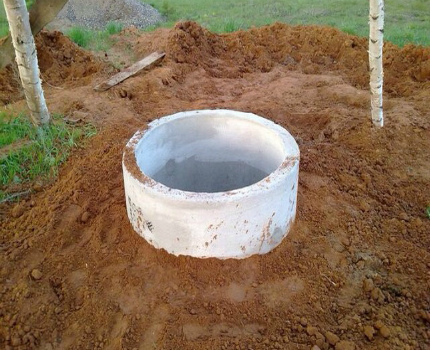
The clay lock prevents flood water, melt and rainfall from affecting the concrete walls of the septic structure
It is not recommended to do it immediately, but after the soil has settled and compacted. The castle made earlier will be destroyed if the soil subsides. Clay is covered with small layers, each time carefully tamped. The material must adhere over the entire surface. The slightest voids are not allowed, otherwise the work done will not give a result.
Roll waterproofing of the septic tank surface
This type of material is used to waterproof the outer surface of reinforced concrete rings. First, to improve adhesion, the surface of the rings is primed using compounds of the "Betokontakt" type. When the layer dries up, visible defects on the walls of the septic tank are eliminated by filling cavities and cavities with a solution including cement, sand and PVA glue. Seams are closed between the rings. When the repair patches are dry, they are primed.

Roll waterproofing should be installed after all defects on the surface of the concrete rings have been eliminated
To fix the rolled material on the surface of the rings, the walls are coated with tar or bitumen mastic, and then the waterproofing is glued. One layer is not enough, 3-4 layers are practiced. At the end, take the mastic and apply it to the seams between the stripes.
Plaster under pressure
For internal and external waterproofing, plaster under pressure is also used. Non-shrinking waterproof cement is supplied under high pressure generated by compressed air. The sealing layer is uniform and dense.
The use of this method is not always justified due to the considerable financial costs. To implement it, you need to have a special device, the so-called "cement gun". The work is carried out at a temperature of at least +5 degrees C, 2 layers are laid, each thickness is from 5 to 10 mm.
To apply the next layer, you have to wait until the previous one is completely set, and this sometimes takes up to 2 weeks. To prevent cracking of the cement on a hot day, it is moistened every 3.5 hours. In cool weather, the interval is increased to 12 hours.
Penetrating or capillary waterproofing
This type of waterproofing is the most reliable. Materials, after being applied to a concrete surface, penetrate into the pores, crystallize, and fill all voids. Thread crystals are embedded in the structure of concrete, clog microcracks and become one with its body. They do not impair the air permeability of the surface, but, by compacting its structure, do not let water through.
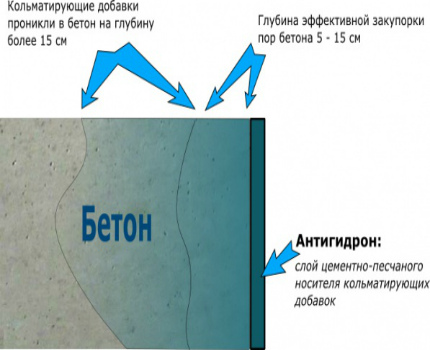
Penetrating insulation improves the quality of concrete, makes it strong and moisture resistant
Crystalline hydrates do not decompose and are not washed out of concrete, so this protection of the septic tank lasts for a long time. The layer on the surface of the rings only fixes, and for some time retains the active chemical components that play a major role in creating high-quality waterproofing of the structure. Some manufacturers claim that once all chemical processes are complete, the layer can be removed.
The duration of crystallization and the depth of penetration of the insulating material into the concrete is affected by the degree of porosity and moisture content of the septic tank rings. At high humidity parameters, crystals form faster, and when this indicator decreases, the process slows down. On concrete surfaces treated in this way, microcracks will heal by themselves.
Penetrating waterproofing, popular formulations
The application of penetrating waterproofing is preceded by a thorough surface treatment. It is completely cleaned using special chemical solutions or a mechanical method. When the result is a flat surface, it is saturated with moisture, pouring water from a hose under high pressure. The active components of the waterproofing compound will penetrate to the same depth as water.
Processing begins with the seams. It is best to do this while mounting the rings. They are laid on a layer of cement mortar, then treated with a penetrating mixture. Further, the mixture is applied to the entire surface, strictly following the manufacturer's instructions, otherwise the waterproofing layer will not meet the stated requirements.
The mixture is prepared in small portions. To mix it with water, an electric drill is used, operating at low speeds and equipped with a spiral nozzle. The composition is applied to the surface of the rings using a spray gun, roller or paint brush. You need at least 2 coats with an application interval of 1.5 to 3.5 hours.
The second treatment begins when the first layer has not yet had time to dry completely. You should get a coating with a total thickness of 1.5-2 mm. It takes a lot of material - about 1 kg per 1 sq. m.
For penetrating waterproofing, the following compositions are used:
- "Lakhta". Inexpensive dry mix made from cement.
- "Kalmatron". The composition includes Portland cement, sand, patented active reagents.
- "Hydro S". Mineral based waterproofing coating.
- Penetron. A penetrating mixture that creates a barrier that prevents liquid capillary infiltration.
If you treat the septic tank from the outside and inside, then in the end you will have a durable sealed structure with a homogeneous structure.
Materials for sealing inter-ring seams
Seams between reinforced concrete rings - the weak link of the septic tank. Most often, the first leaks appear here. For this reason, it is necessary to seal them. Reinforcing cloth, rubber band seals, rubber gaskets with bentonite granules, polymer cement in combination with jute or hemp rope are used as an insulator.
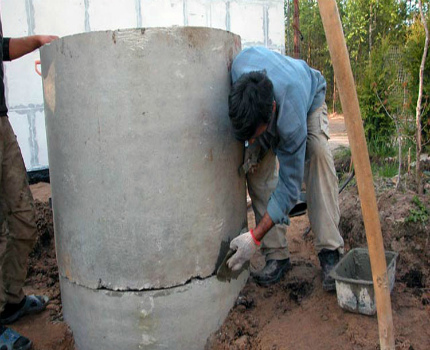
Water begins to seep through the seams between the rings in the first place, so waterproofing should be started by sealing them
In the first and second cases, the insulation is effective, but it is expensive, and the reinforcing fabric must also be irradiated with ultraviolet light. Rubber pads are cheaper, they fill the gaps, creating a plastic layer. They are selected based on the thickness of the walls of the concrete rings.
Manufacturing firms that produce penetrating waterproofing produce auxiliary mixtures. They are used to seal not only the seams between the rings, but also pipe entries, wide cracks. They also include high-quality cement, quartz sand of the finest fraction, chemically active additives. They have excellent adhesion to concrete.
To close a seam or crack, a groove is made along them with a grinder and a perforator to a depth of 2.5-3 cm and the same width. They clean it from dust, small particles, moisten it with water, apply a primer. When the primer dries up, fill the strobe with an auxiliary composition. After the seam and part of the surface around it, they are treated with the main waterproofing mixture.
Among the additional materials there is a group designed to eliminate pressure leaks. They are characterized by fast setting with simultaneous expansion. Around the leak, they simply clean the surface, then make a dovetail-shaped sample with a puncher. A plug is formed from the mixture, with dimensions slightly exceeding the dimensions of the sample, pressed with effort into the place of leakage, and held until complete adhesion.
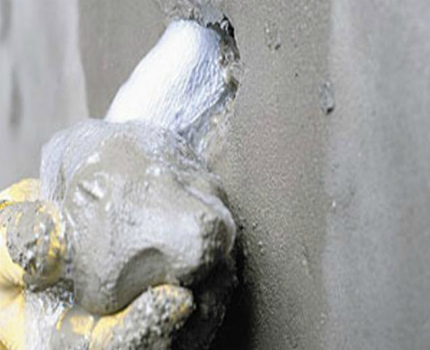
Leaks are not uncommon in a septic tank, so you always need to have a remedy on hand to eliminate it.
When the water stops flowing out, the cavity is primed with the main composition, completely filled with an additional solution, allowed to dry, and moistened. Next, a 2-layer coat is applied using a basic waterproofing mixture. If the technology is followed, the probability of a recurring leak is 0.
Popular adjuvants include:
- "Waterplag"... Hydro-seal is used to eliminate weak leaks. Grabs within 3 minutes.
- "Peneplag"... The quick-setting mixture stops the most intense flow in 40 seconds.
- AQUAFIX... A hydraulic plug that hardens under the influence of moisture in a short time, therefore, is well suited when you need to eliminate a leak.
- "Penekrit"... Used for sealing joints, places of entry of pipes into a septic tank.
- MEGACRET-40 - repair composition based on cement with the inclusion of polymers. Suitable for both sealing ring seams and filling cracks. It has excellent adhesion to the concrete surface, easy to apply, does not shrink.
All manufacturers claim that their blends have a unique proprietary formulation. In fact, their characteristics, as well as the methods of creating a protective layer, are approximately the same. The final result is influenced by the quality of the surface and waterproofing composition.
Video reviews on how to waterproof a septic tank
Here you will see how active leaks are eliminated:
A video clip on how to fasten concrete rings so that they do not move in relation to each other:
When using any option for waterproofing a septic tank, remember that exact adherence to technology is a guarantee of obtaining a high-quality durable coating. Do not ignore the recommendations of the manufacturers regarding both the preparation of mixtures and their application.



